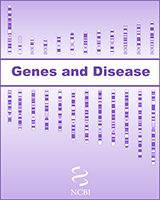NCBI Bookshelf. A service of the National Library of Medicine, National Institutes of Health.
National Center for Biotechnology Information (US). Genes and Disease [Internet]. Bethesda (MD): National Center for Biotechnology Information (US); 1998-.

Best disease, also known as Vitelliform Macular Dystrophy type 2 (VMD2), is a heritable disorder occurring primarily in European Caucasians. Individuals with Best disease generally show a gradual loss of visual acuity starting in their teenage years, although the frequency with which an affected individual may show symptoms and the severity of those symptoms are highly variable.
Best disease is autosomal dominant; in other words, a mutation in only one copy of the VMD2 gene located on chromosome 11 may result in development of the disease. Prior to their vision loss, individuals with Best disease accumulate a mass of fat-like material that resembles an egg yolk (vitelline is a word that means yolk-like) in the area of the retina responsible for central vision. Surprisingly, it is the breakup of this mass rather than its formation that is associated with the gradual vision loss characteristic of Best disease.
Little is known about the protein product of the VMD2 gene, although its function seems to be restricted to an area of the eye known as the retinal pigment epithelium. There is speculation that the protein encoded by VMD2 may be involved in the removal and/or processing of photoreceptor components. Determination of the VMD2 protein function and development of an animal model will be the next crucial steps toward a better understanding of Best disease.
Related diseases
- Genome view see gene locations
- Entrez Gene collection of gene-related information
- BLink related sequences in different organisms
- Research articles online full text
- Books online books section
- OMIM catalog of human genes and disorders
- Foundation Fighting Blindness searching for treatments and cures for retinal degenerative diseases
- Best disease - Genes and DiseaseBest disease - Genes and Disease
- Cfh complement factor H [Rattus norvegicus]Cfh complement factor H [Rattus norvegicus]Gene ID:155012Gene
- RLT2 Homeodomain-like transcriptional regulator [Arabidopsis thaliana]RLT2 Homeodomain-like transcriptional regulator [Arabidopsis thaliana]Gene ID:834441Gene
Your browsing activity is empty.
Activity recording is turned off.
See more...
